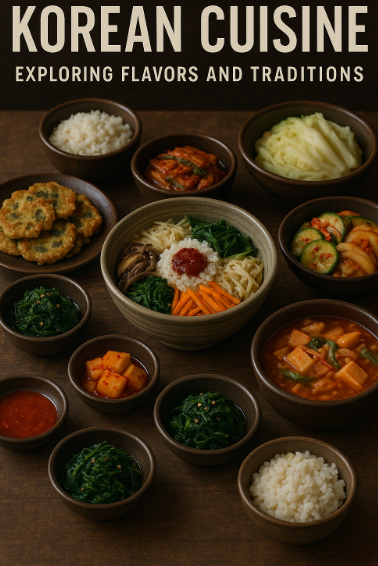Introduction to Korean Cuisine
Korean cuisine is a vibrant and diverse culinary tradition that offers a unique blend of flavors and ingredients. Known for its balance of spicy, sweet, and savory tastes, Korean food emphasizes freshness, seasonality, and healthfulness. With a growing global interest, let’s dive into what makes Korean cuisine so special and how you can explore these flavors in your own kitchen.
Traditional Korean Dishes
Traditional Korean dishes are known for their uniqueness and diversity. Among the most popular are Kimchi, a fermented vegetable dish, and Bulgogi, marinated beef. These dishes reflect Korea’s deep-rooted tradition of fermentation and grilling.
Kimchi, often made with napa cabbage or radishes, is a staple in Korean meals. It’s rich in probiotics and vitamins, contributing to its reputation as a healthy dish. Bulgogi involves thin slices of beef marinated in a mixture of soy sauce, sugar, sesame oil, and garlic, then grilled to perfection.
Unique Ingredients and Cooking Methods
Korean cuisine is distinguished by its use of specific ingredients and cooking techniques. Rice, soy sauce, garlic, sesame, and red chili paste, known as gochujang, are fundamental components in many dishes.
A typical Korean meal might include rice, soup, and several Banchan (side dishes). Steaming, grilling, and fermenting are common cooking methods that enhance the flavors and nutritional value of the food.
The Influence of Korean Food Globally
Korean cuisine has expanded dramatically beyond its borders, influencing global food trends. The rise of K-pop and Korean dramas has also shone a spotlight on Korean food, boosting its popularity worldwide.
Many international chefs are inspired by Korean ingredients and techniques, creating fusion cuisines that blend Korean flavors with other culinary traditions. This global recognition adds to Korea’s position as a significant player in the culinary world.
Exploring Korean Cuisine at Home
Embracing Korean cuisine at home is easier than ever with the availability of global markets and online resources. Cooking Korean dishes allows you to experience the rich culture of Korea while experimenting with flavors.
Start with simple dishes like Bibimbap, a rice bowl topped with vegetables, an egg, and chili paste, or Samgyeopsal, grilled pork belly, to immerse yourself in the delicious world of Korean cooking.
Korean Food Culture and Dining Etiquette
Korean dining is as much about the experience and social interaction as it is about the food itself. Meals are often shared, with an emphasis on community and connection.
Traditionally, Koreans use metal chopsticks and spoons, and it is customary to wait for the oldest person at the table to start the meal. Understanding these practices enhances the cultural experience of enjoying Korean cuisine.
Comparison of Popular Korean Dishes
| Dish | Type | Main Ingredients | Cooking Method |
|---|---|---|---|
| Kimchi | Side Dish | Cabbage, Red Chili Powder | Fermentation |
| Bulgogi | Main Course | Beef, Soy Sauce, Garlic | Grilling |
| Bibimbap | Main Course | Rice, Vegetables, Egg | Mixing |
FAQs
Q: What is Kimchi and how is it made?
A: Kimchi is a fermented vegetable dish, primarily made with napa cabbage and radish. It’s seasoned with red chili powder, garlic, and ginger, then left to ferment for several weeks.
Q: Is Korean cuisine spicy?
A: While many Korean dishes are known for their spicy kick, not all Korean food is spicy. There are plenty of mild dishes that emphasize savory and sweet flavors instead.
Q: Can I find Korean ingredients easily outside of Korea?
A: Yes, many international supermarkets and Asian grocery stores offer a range of Korean ingredients. Online shopping is also a convenient option to find specific items.
Summary
- ✅ Korean cuisine is a harmonious blend of spicy, sweet, and savory flavors.
- ✅ Traditional dishes like Kimchi and Bulgogi are staples of Korean meals.
- ✅ Unique ingredients and cooking methods define Korean food.
- ✅ Korean cuisine’s global influence is growing rapidly.
- ✅ Understanding Korean dining etiquette enhances the culinary experience.
#KoreanCuisine #Kimchi #Bulgogi #Banchan #Gochujang #Kfood #KoreanFlavors #KoreanTradition #KoreanIngredients #CuisineCulture #KoreanDining #Kpop #KoreanWave #KoreanFusion #KimchiRecipes #Bibimbap #Samgyeopsal #HealthyEats #KoreanCooking #KoreanTradition #Fermentation #AsianCuisine #GlobalCuisine #FoodCulture #KoreanDesserts #DiningEtiquette #KoreanSoup #SoySauce #RedChiliPaste #KoreanRecipes #KoreanFoodBlog #TasteOfKorea


https://shorturl.fm/xE2vn
https://shorturl.fm/Um5TX
https://shorturl.fm/89LhI
https://shorturl.fm/20LW6
https://shorturl.fm/bMAUc